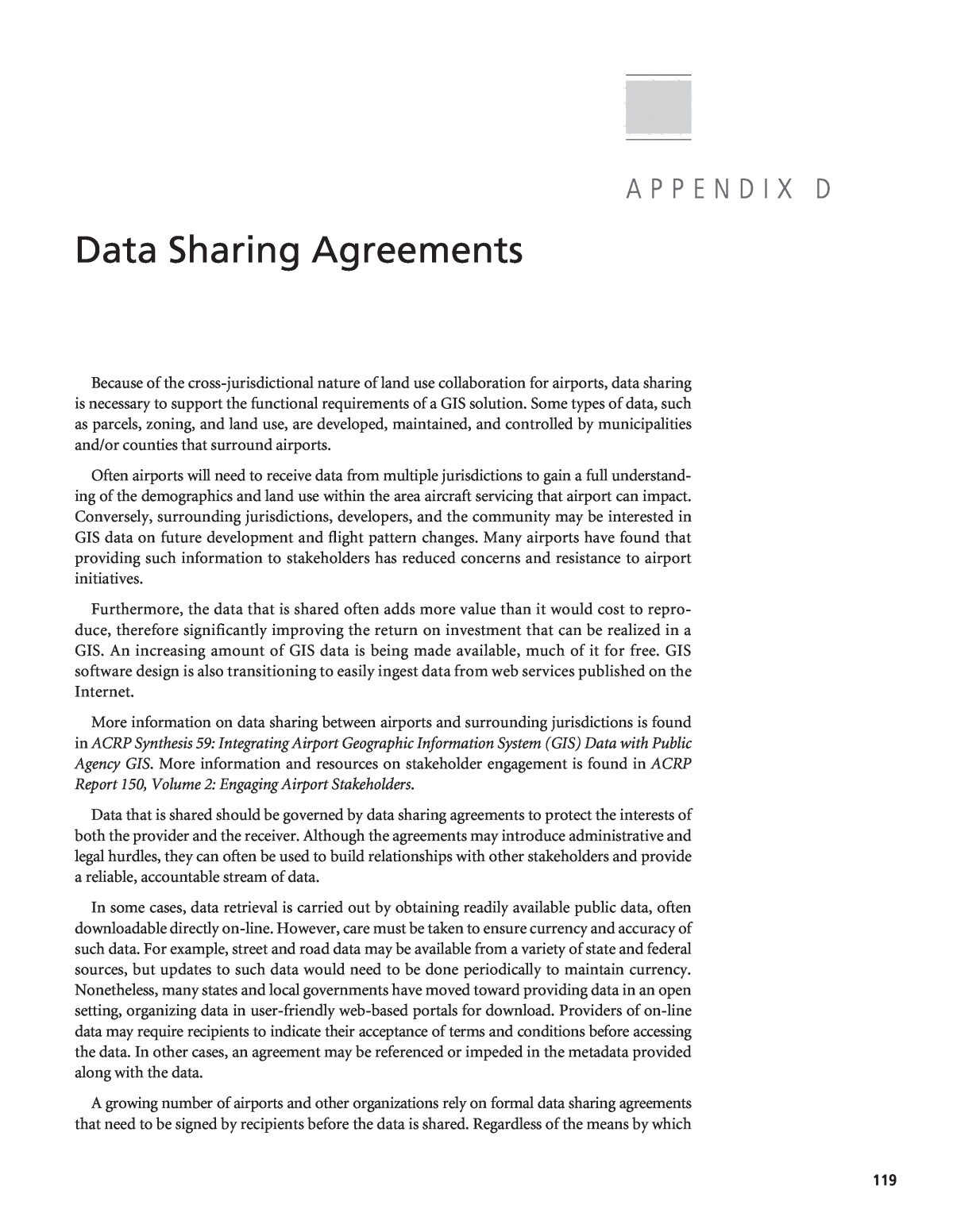

Below is the uncorrected machine-read text of this chapter, intended to provide our own search engines and external engines with highly rich, chapter-representative searchable text of each book. Because it is UNCORRECTED material, please consider the following text as a useful but insufficient proxy for the authoritative book pages.
119 Because of the cross-jurisdictional nature of land use collaboration for airports, data sharing is necessary to support the functional requirements of a GIS solution. Some types of data, such as parcels, zoning, and land use, are developed, maintained, and controlled by municipalities and/or counties that surround airports. Often airports will need to receive data from multiple jurisdictions to gain a full understand- ing of the demographics and land use within the area aircraft servicing that airport can impact. Conversely, surrounding jurisdictions, developers, and the community may be interested in GIS data on future development and flight pattern changes. Many airports have found that providing such information to stakeholders has reduced concerns and resistance to airport initiatives. Furthermore, the data that is shared often adds more value than it would cost to repro- duce, therefore significantly improving the return on investment that can be realized in a GIS. An increasing amount of GIS data is being made available, much of it for free. GIS software design is also transitioning to easily ingest data from web services published on the Internet. More information on data sharing between airports and surrounding jurisdictions is found in ACRP Synthesis 59: Integrating Airport Geographic Information System (GIS) Data with Public Agency GIS. More information and resources on stakeholder engagement is found in ACRP Report 150, Volume 2: Engaging Airport Stakeholders. Data that is shared should be governed by data sharing agreements to protect the interests of both the provider and the receiver. Although the agreements may introduce administrative and legal hurdles, they can often be used to build relationships with other stakeholders and provide a reliable, accountable stream of data. In some cases, data retrieval is carried out by obtaining readily available public data, often downloadable directly on-line. However, care must be taken to ensure currency and accuracy of such data. For example, street and road data may be available from a variety of state and federal sources, but updates to such data would need to be done periodically to maintain currency. Nonetheless, many states and local governments have moved toward providing data in an open setting, organizing data in user-friendly web-based portals for download. Providers of on-line data may require recipients to indicate their acceptance of terms and conditions before accessing the data. In other cases, an agreement may be referenced or impeded in the metadata provided along with the data. A growing number of airports and other organizations rely on formal data sharing agreements that need to be signed by recipients before the data is shared. Regardless of the means by which A P P E N D I X D Data Sharing Agreements
120 Using GIS for Collaborative Land Use Compatibility Planning Near Airports data sharing agreements are conveyed by the provider and agreed to by the recipient, they should address9 the following topics: ⢠Parties, including but not necessarily limited to the provider and recipient(s) of the data should be clearly defined. Other parties may include 3rd parties that may be permitted to access the data and other organizations that hold rights to some or all of the data. ⢠The authority which establishes the right to share the data and govern its use should be clearly stated. In many cases this is the provider, but in some cases other organizations, vendors, or laws may have additional authority over the data. ⢠A description should include the subject and extent of the data that is being shared. ⢠The purpose as to why the data is being provided and why it is needed should be explained. ⢠Definitions should establish a common understanding of any legal or technical terms of the agreement. ⢠Permissions conveyed by the authority to the recipient should cover how the data is to be used, handled, and disseminated to third parties. ⢠Confidentiality of the data that the authority requires of the recipient to maintain should be clearly stated. ⢠Representations, disclaimers, and usage constraints should be explained so that the recipient does not use the data in inappropriate ways or in ways that exceed the capabilities of the data. Any known issues or constraints in how the data should be used should be explained. ⢠Time limitations may be applied to limit how long the recipient may use the data. ⢠Usage limitations or licenses may be imposed to constrain the use of the data to a particular purpose or location. ⢠The recipient may be required to report or notify the provider if the data is used outside of limitations or licenses in the agreement. ⢠Contact information should be provided for all the parties to the agreement. ⢠Return provisions may be imposed to require that the recipient return or destroy the data and any copies it has made once the time or usage limits have been exceeded. ⢠Severability and termination conditions should establish if and how either party can termi- nate the agreement if needed beyond any time limitations. References to Sample Data Sharing Agreements ⢠9-1-1 GIS Data Sharing Agreement: https://www.oregon.gov/oem/Documents/sample_gis_data_sharing_agreement.pdf Last Viewed: August 14, 2018 ⢠Intergovernmental Data Sharing Agreement for the Saginaw Area GIS Authority Digital Geographic Data Sets, Saginaw Area GIS Authority: https://www.sagagis.org/?mdocs-file=610 Last Viewed: August 14, 2018 ⢠GIS Digital Data Sharing Agreement, City of Lakeland, Tennessee: https://www.lakelandtn.gov/DocumentCenter/View/1979 Last Viewed: August 14, 2018 Reference to Data Sharing Policies and Procedures ⢠GIS Data Sharing Policies and Procedures, GIS Division, City of Chicago Department of Business and information systems: https://www.cityofchicago.org/dam/city/depts/doit/general/GIS/GIS_Data/Data_Sharing/ _GIS_DataSharingPolicy.pdf Last Viewed: August 14, 2018
